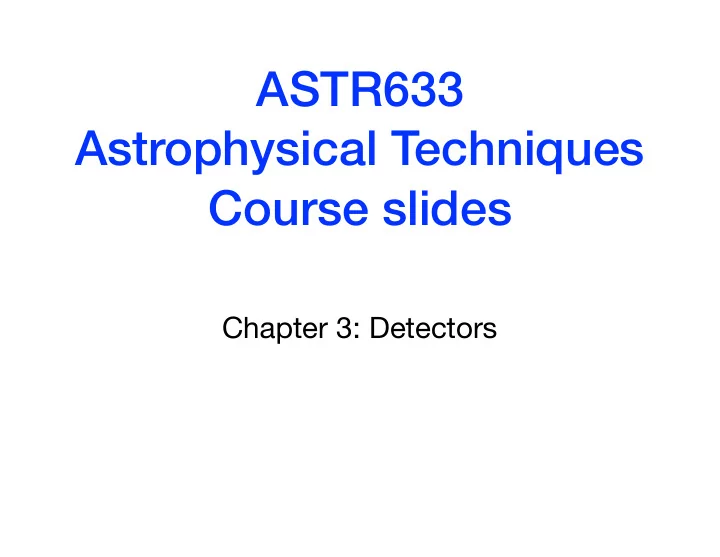

ASTR633 Astrophysical Techniques Course slides Chapter 3: Detectors
Fundamental principle is for light-detecting material to absorb a photon and thereby release one (or more) electrons, which is then detected. Optical array detectors (CCDs) became widespread in 1980s (Nobel Prize in 2009 to its inventors), and near-IR array detectors in the 1990s. Optical: - Light-detecting material is silicon, sensitive from 0.3-1.1 µm. - Largest individual arrays are 6K x 6K, though “arrays of arrays” (a.k.a. mosaics) are common, e.g. Keck/LRIS has two 2K x 4K with no gaps (buttable). - Largest camera is Pan-STARRS1 GPC, 64 x 64 mosaic of 600 x 600 pixels = 1.4 Gigapixels Near-IR: - Two common choices of material are HgCdTe (0.8-2.5 um) and InSb (0.8-5.5 um). - Largest individual arrays are Hawaii-4RG = 4096 x 4096 pixels = 17 million pixels - Largest mosaic is UK’s VISTA camera, with 16 2K x 2K arrays = 67 million pixels. However, IR arrays are not buttable due to readout electronics so IR mosaics have gaps.
What are valence and conduction bands? Figure 3.1
Crystal structure for semi-conductors Figure 3.2
Bandgap diagrams Figure 3.3
Absorption coefficients Figure 3.4
Noise - Johnson-Nyquist noise - Dark current - Read noise Describe each one and how to mitigate their e ff ects
What is the dynamic range? Figure 3.5
Physical arrangement of Si:As detector Figure 3.7
Band diagram Figure 3.8
Photodiodes Oppositely doped semiconductors adjacent to each other Figure 3.10
Charge Coupled Devices Figure 3.16
CCD Readout Each pixel consists of 3 electrodes Well depth ~ 10 5 electrons Figure 3.17
https://commons.wikimedia.org/wiki/File:CCD_charge_transfer_animation.gif
CCD Readout Figure 3.18
Veiga et al. 1998, A&A Suppl., 136, 455
Tonry et al. 1997
Image Intensifier Figure 3.23
Recommend
More recommend